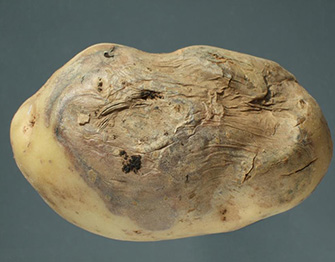Please click here to access the main AHDB website and other sectors.
- Home
- Knowledge library
- Gangrene
Gangrene

Gangrene is a slow growing fungal disease of stored potatoes favoured by cool climates.
Symptoms
The first symptoms of gangrene are small round dark depressions that may appear dark grey to brown. These grow to resemble thumb impressions and may coalesce and overlap, leaving ridges in between. Wrinkles tend to stretch across rather than the concentric rings expected with dry rots. There is no outward eruption of mycelial growth unless a secondary infection is involved. The external size of the lesion is no indicator of internal damage as there might be little penetration or extensive cavitation. White or yellow mycelial growth can be seen on the inner surfaces of these cavities. Gangrene rots are frequently very dark and have a sharp border against healthy tissue. Clusters of small black spore bodies called Pycnidia, are diagnostic but they are not always present.
Conditions
Problems might be expected where harvesting is delayed by cold and wet weather but no plant symptoms can indicate the likelihood of symptom development. Damage is by far the most common initiator of the infection and it is often easy to locate the original wound. Gangrene would be expected to occur in colder storage conditions where there has been inadequate curing.
Control
Limiting handling damage is the best prevention. Earlier harvesting and dry curing will also help avoid issues. Annual store cleaning programmes will prevent spores bridging one season’s problem to the next.

